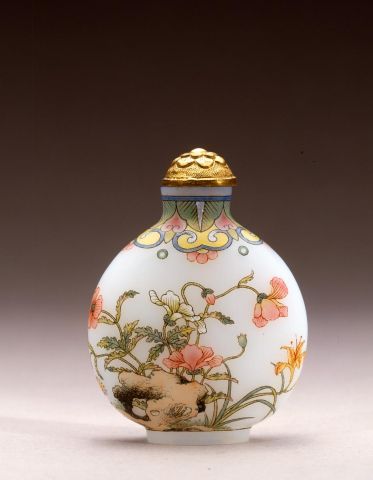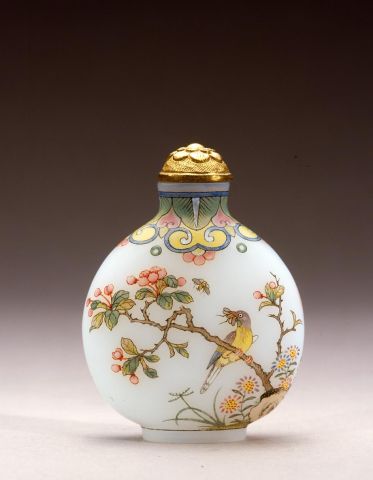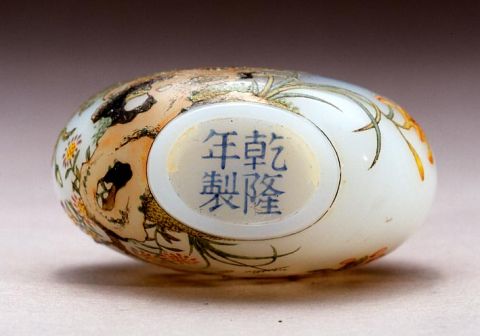


Bottle ID: 00148
YE BENGQI, WHITE, BIRD ON A BRANCH & LANDSCAPE SCENES
Date: circa 1933 - 1943
Height: 46 mm
Glass, of rounded form with a neatly carved footrim, the milk-white glass painted in famille rose enamels with a continuous design of a bird clutching a bee in its beak, seated on the branch of a blossoming crab apple tree and looking back at a bee about to alight on one of the blossoms, with daisies growing below beside a rock; the reverse with clusters of pink and white poppies, daisies and day lilies springing from convoluted rockwork; below a band at the neck of leaves above scrolling lingzhi above flower-heads; the base with a blue enamel four character Qianlong nianzhi mark in regular script.
Attributed to Ye Bengqi.
Similar Examples:
Crane Collection nos. 189 and 297.
Moss Hugh, Victor Graham and Ka Bo Tsang. The Art of the Chinese Snuff Bottle - The J & J Collection, 1993, Vol. I, pp. 352-353, no. 205.
Xia Gengqi, Zhang Rong. Masterpieces of Snuff Bottles in The Palace Museum, Beijing, 1995, p. 116, no. 105.
Sotheby's, New York, October 25, 1997, lot 12.
Provenance:
Clare Lawrence Ltd.
Joseph Baruch Silver
Clare Lawrence Ltd.
Sotheby's, Hong Kong, November 15, 1988, lot 80
Ex. Coll. Mr. and Mrs. Paul Bernat, Massachusetts
Frank Caro Ltd., NYC
Belle Schoen
Mr. and Mrs. Martin Schoen
C. T. Loo & Co., Ltd., NYC
Exhibited:
Annual Convention ICSBS Toronto, October 2007
Honolulu Academy of Arts, Honolulu, Hawaii, November 23, 1989 - January 7, 1990
China Institute in America, New York, December 1, 1952 through January 13, 1953
Published:
JICSBS, Winter 2008, p. 13, figs. 18a and 18b
Chinese Snuffbottles from the Collection of Joseph Baruch Silver, Jerusalem, Israel, 1989 [ Addendum ]
H. M. Garner & M. Medley, Chinese Art in Three Dimensional Colour, Vol. IV, reel 33, #6
Moss, Hugh. By Imperial Command - An Introduction to Ch'ing Imperial Painted Enamels, 1976, pp. 65-67, Pl. 47
China Institute in America, New York, December 1, 1952 through January 13, 1953, pp. 8-9, no. 17
Although part of the inside painting studio known as the Apricot Grove Studio, Ye Bengqi is perhaps best known for his enameling skills. The Crane bottle shows Ye Bengqi at his best; with its delicate shading and fine painting this bottle is comparable to an eighteenth century Imperial enamel on glass bottle. The reason for this, of course, lies in the proximity of Ye Bengqi to the Palace during his training. Ye Bengqi was the third son of Ye Zhongsan and, although he learned the skill of inside painting, he was already fourth in line behind his father and his two older brothers. Ye Bengqi was taught enameling by his father, Ye Zhongsan, who in turn was apparently taught the art by his grandfather. It is not possible to separate the extant bottles enameled by Ye Zhongsan, and as a consequence, bottles of this period of enameling are all attributed to Ye Bengqi.
Much of the information we have about Ye Bengqi comes from a series of interviews with him by Hugh Moss in 1974, over thirty years ago. Although Ye was an older man at this point, Moss was still relatively young and fortunately he documented the information given to him by Ye.
The kiln used at the Apricot Grove Studio was a small family run kiln which took only one object at a time. It was a clay-lined kiln and used "white" charcoal for the firing, which took an average of two hours including a cooling period. It was not scientifically controlled and Ye estimated that only 30% of his pieces were successful. Each object, which included miniature vases, brushwashers and other small scholars' works of art, in addition to snuff bottles, needed to be fired at least four times as enamel colors were added to the initial design sketched in black enamel.
Ye Bengqi studied for at least three years (around 1920), before he began enameling bottles. He told Moss that he thought his first "real" enamel bottle was made around 1924 after using chipped or broken glass bottles to practice on. He developed his art over the next few years reaching a peak in quality between 1933 and 1943 when his best works were produced. After 1949, he did very little enameling, although he was responsible for teaching the art to his student, Wang Xisan, who became a master in his own right. The bottles that Ye Bengqi produced were made for commercial purposes and were sold to Beijing dealers, who in turn sold them as eighteenth century Palace originals. This has led to some confusion today as some of Ye Bengqi's copies are as good as the originals. However, his copies are never exact as he had to sketch from memory after his visits to the Palace Museum.
The milk-white glass bottles that Ye Bengqi used came from at least two known sources. More rarely, he was able to find older blanks that could be used for enameling. There was also a glass maker in Beijing known as Glass Bottle Zhou (Zhou Liaohu) who produced blanks for Ye Bengqi. Very little is known of him except that he lived in Beijing outside the Zhongwen Gate and used his own private kiln for making glass objects, including snuff bottles. He also copied antique glass, in various colors, including overlay pieces. One of Zhou's students was named Sun, who cannot be traced and would now be deceased.
Ye Bengqi also used bottles with a yellow or gold ground to imitate the Palace originals, even some bottles of the classic double gourd form. The majority of Ye's works are produced using the heaping method, with layers of thick opaque enamels in a famille rose palette, resulting in a more three dimensional decoration which was very vivid in tone (although not as bright as Wang Xisan's work). The base mark was executed as either a "heaped" four character Qianlong nianzhi mark or a two character Qianlong mark, or very rarely a Guyue Xuan mark, all in blue enamel. The heaping method, with its multiple firings seemed to avoid the pitting evident on eighteenth century enamels.
Ye's finest works are of flowing bird and flower designs with intricately worked borders. Very occasionally, Ye Bengqi also did landscapes, allegedly about ten, some with "puddingstone" marbled borders, again in imitation of the Palace style.
Moss' recent re-evaluation of his earlier research raises some interesting questions relating to his series of interviews with Ye Bengqi. Although Ye claimed that he started enameling commercially in 1924 after studying at the Palace Museum for four years, the museum was not open to the public until October, 1925. Moss concludes, therefore, that Ye Bengqi had, in effect, no "Imperial" enamels on glass to copy in 1924 and that it was likely that some bottles claimed by Ye Bengqi as his own, are in fact, original eighteenth century enamels. This, according to Moss, includes some bottles from the Ko Collection which were purchased in Beijing between 1921 and 1924. While this conclusion is possible, there is another viable scenario. The "Imperial" enamels from the Ko Collection purchased in Beijing confirm the fact that bottles were being removed from the Palace around this time and passed to dealers in Beijing who were selling them. These were the same dealers who were buying Ye's copies for forty yuan and selling them also as Palace originals for two thousand yuan. If these dealers had original "Palace" bottles, it is entirely likely that Ye Bengqi would have been shown them and even be asked by the dealers to copy them. Ye Bengqi may not have wanted to reveal this to Moss in order to save face and may have simply stated that he had been going into the Museum to copy the bottles.
< Back to full list

 English
English 中文
中文